I’ve been grilling for nearly a decade now, and until I moved to a place with a lousy grill1 I did it at least 3 times a week. I figure I have over a thousand sessions in front of the grill and I’ve formed some opinions during that time. What follows is a list of equipment that I use and recommend along with some warnings on what doesn’t work. I’ll try to keep it updated and will add more as I think of it. I’ll post to the main blog when there’s an update.
Grills
I used a Weber gas grill and highly recommend them. I recently wrote about the Weber Spirit 310, however, I wrote it as a general grill buying guide so it’s a good place to start. I owned the predecessor, the Genesis Silver, which is still working today after almost a decade. Three friends bought the Spirit 310 on my recommendation and none of them have yelled at me for it, so I’m feeling pretty confident in the brand.
I’ve heard good things about Ducane and TEC, but I’ve never used them. TEC has been recommended by Steven Raichlen for its infrared cooking system that allows for much higher searing temperatures. If I was buying a grill just to do steaks or rotisserie cooking (which is ideally done with infrared heat), I’d definitely go with TEC to give me a better chance at replicating Ruth’s Chris or Boston Market.
Utensils
All your utensils should be stainless steel. It’s easiest to clean and lasts forever. Iron rusts and aluminum has a low melting point and might be linked to Alzheimer’s. Doctors don’t know what Teflon causes, but I do. It causes you to be pissed off because you paid good money for a Teflon coated utensil and half the Teflon flaked off after a couple uses. Now your utensil is coated with Teflon and rust.
Tongs
The number one utensil is a good set of tongs. You’ll use this more than anything else, as you need it to turn everything that isn’t a burger or fish. Never, ever use a fork to turn things! I’m sorry I yelled, but this is a critical rule. Ever see those BBQ tool sets that include a big fork? They are purposely trying to make a buck at the expense of ruining your dinner. Piercing meat lets out precious juices.
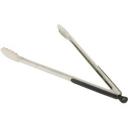
I love my Oxo Good Grips stainless steel locking tongs. I own the 12″ tongs, but I’m recommending the 16″ because 12″ is a little too short for grill work; you really don’t want your hands directly over the burners. As for the locking feature, you might not think it’s important, but I use it all the time. It makes it more compact for storing or just setting down on the side shelf of your grill.
Spatulas
Number 2 is the spatula, of which I own a couple. For burgers, you just want something with a long handle and a square face. As a gift, I received a Pampered Chef BBQ spatula, and I indeed feel pampered while flipping burgers.2 While I’ve never had use for its serrated edge, pointy edge, or bottle opener, those features don’t get in the way of flipping burgers.
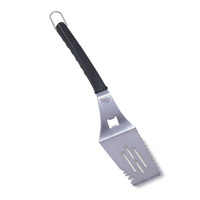
I would also consider this Weber spatula.
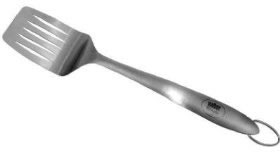
Now fish is a whole ‘nother animal and requires a guide unto itself. The short answer is to avoid fish baskets because nobody has ever designed one that will easily cook skinless fillets on a lidded grill. I will someday post a guide to grilling fish.
Grill Brushes
Every time you grill, you’re going to set your grill to high for 10 minutes and then brush off the ashes. So you need a decent grill brush. The bristles should always be brass, that’s a given. I thought I’d be clever and save money by getting one with a replaceable head, but I was too clever by half. The replacement heads have the bristles embedded in a rubber base that – surprise! – melts over high heat, so the bristles start to fall out. That’s why you need the replacement heads! Instead, buy a cheap brush with a long, wooden handle and a metal scraper on the end. I got mine at Lowes for about $6. Here are a couple that are even cheaper (they qualify for standard free shipping and no tax) and nicer looking (mine was unfinished and got grungy-looking fast):
Kingsford Rosewood Grill Brushes
(this one’s a little more expensive, but it’s 18″ and rosewood, so it’s probably worth the extra buck-fiddy considering you may have it for a few years)

Meat Thermometers
If you’re going to do a roast of some sort (and I’ve done plenty, as well as a few Thanksgiving turkeys), you need a good meat thermometer. I own the Chaney Acu-Rite Digital Instant Read Thermometer. I wanted a digital thermometer to read easier and I’m happy with my purchase; it’s served well for many years. However, I discovered early on that if you stick the thermometer in the meat while it’s on the grill, and you don’t do it so that the roast is completely blocking the heat coming from the grill, the heat will interfere with the electronics and give you a false reading. It’s probably best to take it off the grill for a few seconds to get a reading, but if that’s too much hassle just be careful to put it perpendicular to the grill grate and in the middle of the roast. I don’t know if that’s typical of digital thermometers, but if I had to buy a new one I’d probably go with the much better reviewed and slightly cheaper CDN Proaccurate Stainless Digital Thermometer. It sounds like that one takes a reading much faster than mine, which stabilizes after about 10 seconds.
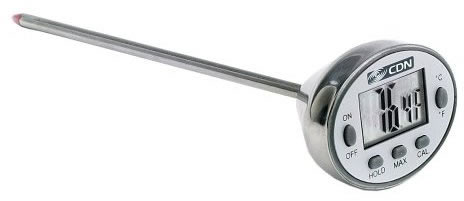
And lest you think there’s an exception, the ban on forks extends to those fork-thermometers. You don’t want to poke any more juice-depleting holes than you have to.
Grill Gloves
When you’re brushing that 600 degree grill grate, it’s nice to have a pair of grill gloves so your hands don’t melt. It turns out that I didn’t buy grill gloves (even though they were marketed as such), I bought welding gloves. Mine are Weldas COMFOflex gloves in bright orange. Note that these will keep your hands from burning from the heat coming off the grill or grease splatter, but if you grab on to the grate or the outside metal of the grill, you can get burned as they’re not super-insulated. They also sell food handling gloves so you can pick up a roast with your hands, but I’ve never used those before. I just rely on tongs for that; if the roast is too big for tongs, I use a roasting pan (see below).
Cutting Boards
I recommend two kinds of cutting boards. For every day chopping and food preparation, get one made of polypropylene with rubberized handles. The handles keep it from slipping on your counter top and the whole thing can be thrown in the dishwasher when you’re done.
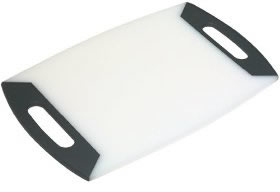
However, for roasts, you really want one like I had growing up: wood with a juice channel and reservoir. Otherwise the juice/blood runs all over the place and makes a big mess. I searched around and the Mundial solid wood cutting board has all the right design marks, including non-slip rubber feet. Medium should handle your average beef and pork roasts, but they also make it in large for when you’re carving that Thanksgiving turkey or prime rib roast.
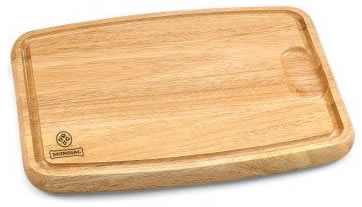
Roasting Pans
Looking at the photographs accompanying the roast recipes offered by your grill mfr., you’d wonder why you’d ever need a roasting pan. Why, you just put the roast directly on the grill grate. And technically you can do that, but the bottom of your roast will get dry and tough and stringy, even with indirect heat. I also find that using a roasting pan for long cooking times helps keep the food from getting dried out, as you can put water in the pan to increase the humidity inside the grill. I’ve cooked a few Thanksgiving turkeys on the grill, as well as some big pork shoulders, and I was glad I used the pan.
You want to find one big enough for your larger cuts, and 16″ is about normal. You want big handles that can fit your hands while wearing oven mitts or grill gloves along with pot holders. I had a pan with hinged handles that laid flat along the sides and weren’t very big, so it was a pain to grab onto it. You want something easy to clean, either stainless or non-stick. But if you get non-stick, you want it designed so the accompanying rack isn’t scratching the coating. I found two that meet these requirements well:
Calphalon Contemporary Stainless 16-Inch Roaster with Nonstick Roasting Rack
(Currently on sale.)
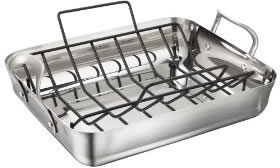
Circulon 16-Inch Rectangular Nonstick Roaster
(I have a couple Circulon pans and I’m a big fan. My big skillet cost almost twice what this roaster costs and I still don’t regret buying it.)
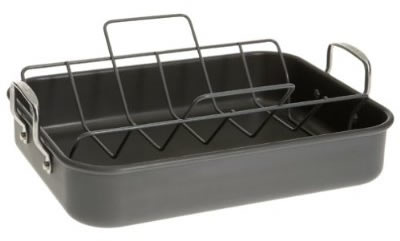
Knives/Cutlery
One of my college roommates was quite the gourmand and his advice on knives was to wait until some big department store put an expensive set of knives on clearance for $100. That’s how I got my J.A. Henckels 7 piece cutlery set, although I think I paid a bit more than $100. Whatever the cost, I’m very happy with it. It comes with a chef’s knife, carving knife, serrated utility knife, paring knife, utility scissors, sharpening steel, and a wooden block for storage. They are all used regularly. The handles feel great, the knives are sharp, the scissors are – as the Zohan would say – silky smooth. What more do you want?
Well, you might want steak knives, but I’ve never been picky on that. Just buy better meat and anything reasonably sharp with a serrated edge will cut it.
You will, however, need a carving fork. Yes, NOW you can use a fork – provided you’ve let the roast sit for 20 minutes. I’ve inherited a Cutco fork that’s over 30 years old and feels new. Go to the store and see how they feel – you want something sturdy that fits your left hand well, assuming you’re cutting with your right.
Cooking/Butcher’s Twine
Butcher’s twine is very handy for tying meat to other pieces of meat (e.g., bacon to fillet mignon, or certain acts of poultry bondage). You can buy it cheap here, but I just asked my supermarket butcher for some. Actually, I asked him where I could buy it, and he just pulled off several feet and gave it to me. I never used it all, so I imagine 370 feet will last your family for many generations.
- It’s a built-in Fire Magic. I’d never heard of that brand before, but apparently it’s pretty expensive. Unfortunately, it’s slow to heat and is missing critical features like a thermometer. [↩]
- Many thanks to Mr. and Mrs. Blade Runner. [↩]

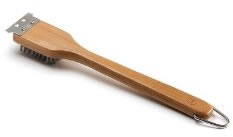
One thought on “Barbecue and Grilling Equipment Buyer’s Guide”